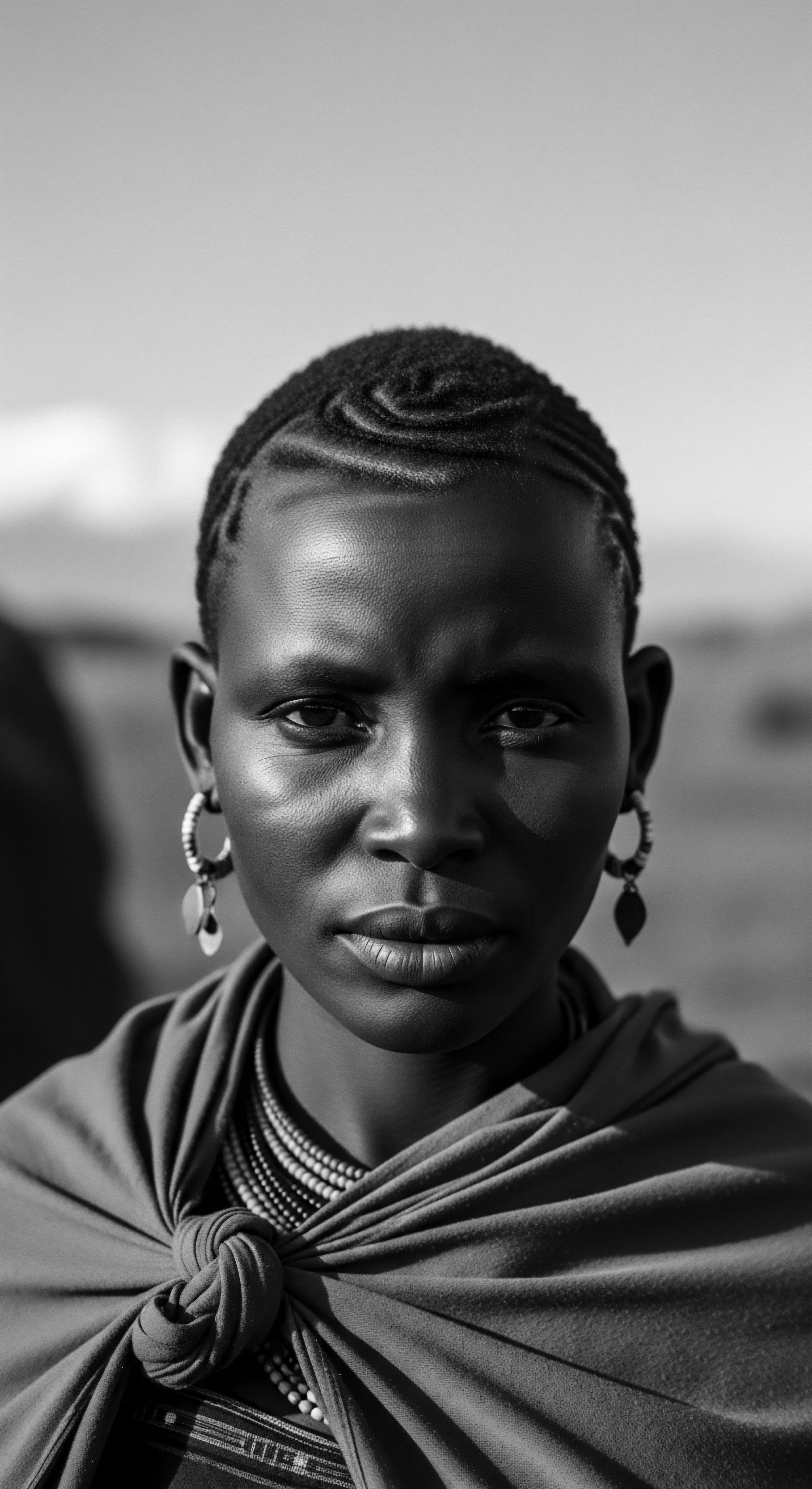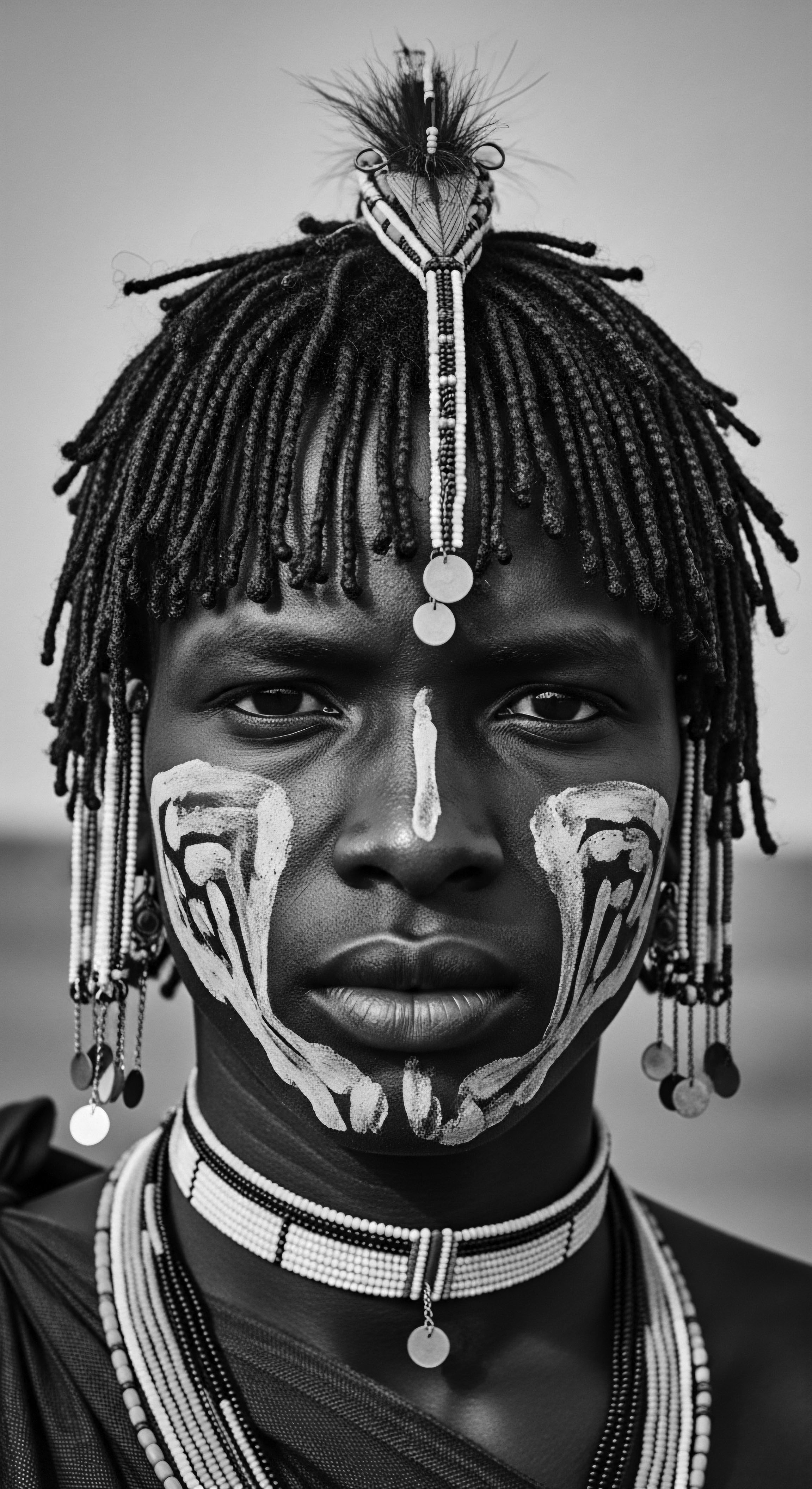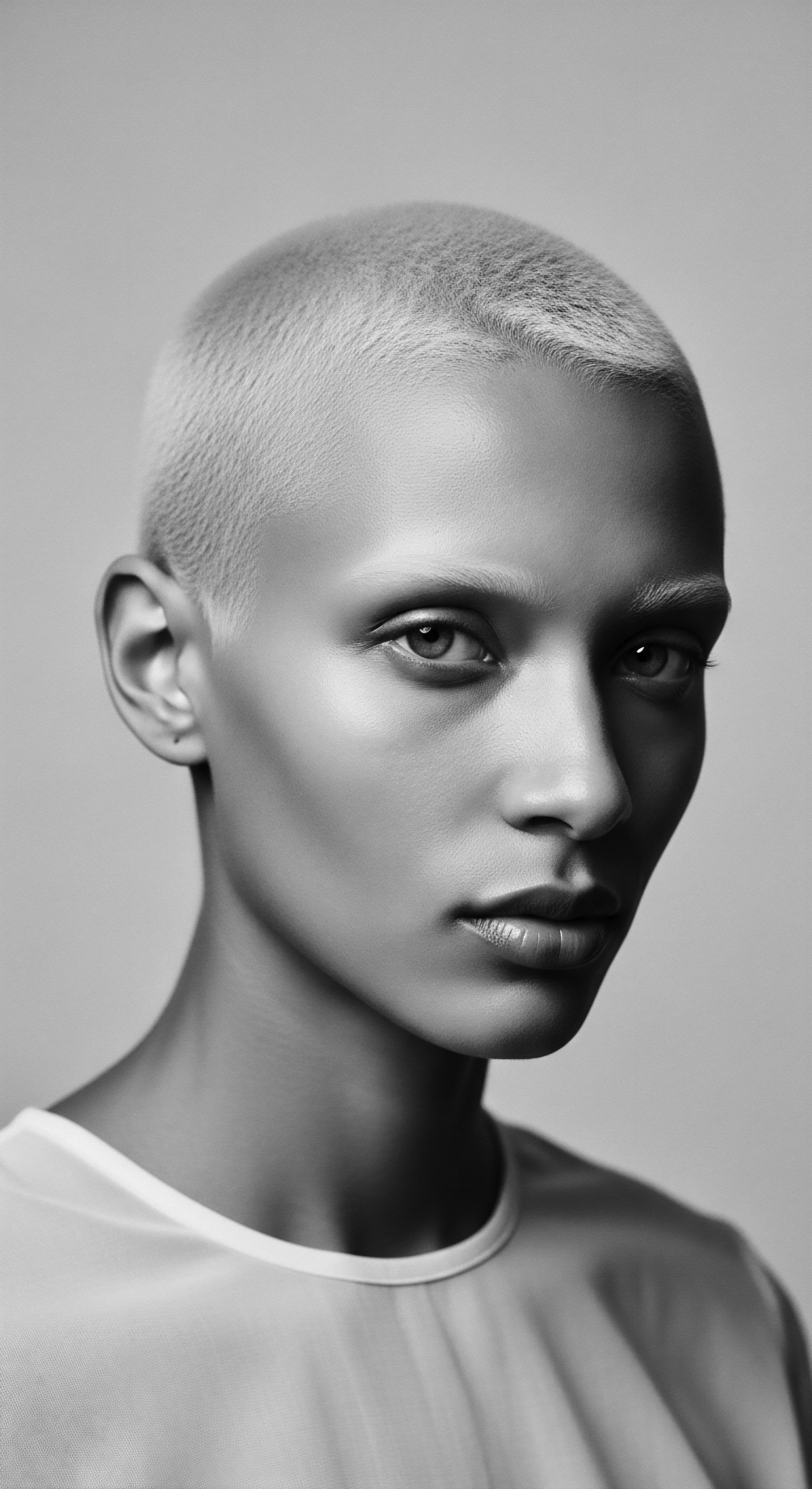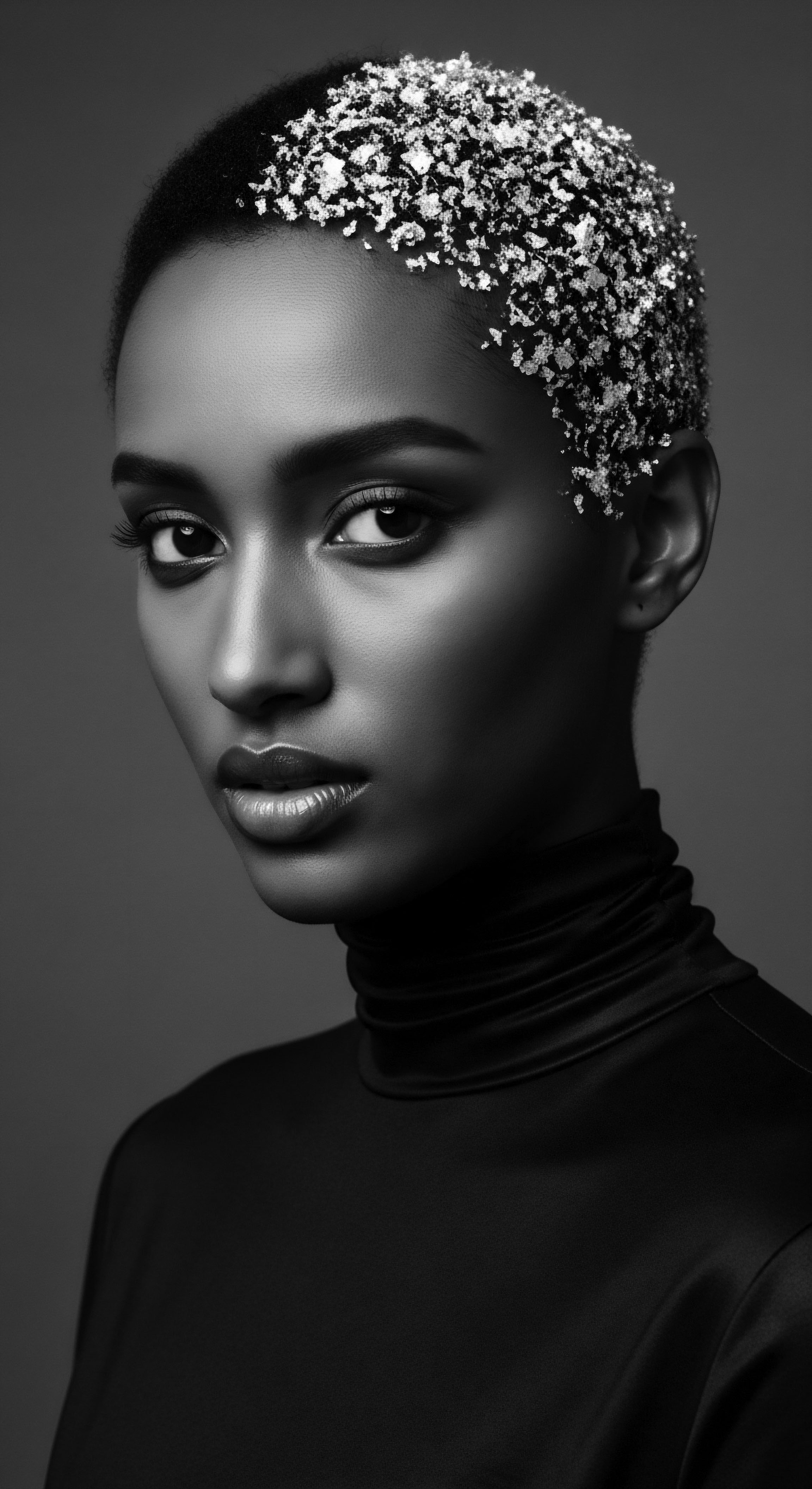
Roots
Consider the deep soil of ancestral memory, where the very strands of our hair, coiled and resilient, whisper stories across time. How did hair communicate status in ancient African societies? It did so not through fleeting trends or arbitrary adornment, but through a language of legacy, interwoven with the spirit, the community, and the very biology of being.
To approach this question, we must quiet the modern world’s clamor and listen for the ancient echoes, tracing the profound heritage held within each curl and coil. This exploration begins at the source, the elemental understanding of textured hair itself, as recognized and revered by those who came before us.

The Architecture of Ancestral Strands
Long before microscopes unveiled the precise cellular structure of hair, ancient African communities possessed an intuitive, observational science of textured hair. They understood its unique properties—its coil, its strength, its capacity to hold intricate styles—and these understandings were foundational to how hair could serve as a communication medium. Afro-textured hair, characterized by its tightly coiled strands and curved follicle, was far from merely a biological attribute.
It was integral to identity, to status, and to societal roles. The wisdom passed down through generations held that the hair, seated at the head, served as the body’s most elevated part, connecting the individual to the spiritual realm and ancestral energies.
Hair in ancient African societies functioned as a profound, living language, speaking volumes about an individual’s place within their community.
This inherent connection between hair and spirit meant that the meticulous care and styling of textured hair were not mundane tasks. They were acts steeped in reverence, communal practices that reinforced social bonds and conveyed a wealth of information without a single word spoken. The coiled structure of textured hair provided a natural canvas for these complex expressions. Its natural ability to form intricate patterns, to be sectioned and adorned, lent itself to detailed visual codes.

Hair as a Genealogical Script
Understanding the fundamental nature of textured hair, its unique resistance to gravity, its ability to hold shape, became a source of ingenuity. In pre-colonial African societies, this unique quality allowed hair to serve as a literal script of one’s life. The varied forms of braids, twists, and locs were not random; they were deliberate statements.
They spoke of one’s family background , their ethnic identity , their geographical origin , even their religious beliefs . This ancestral codex, etched in hair, served as a communal shorthand, immediately placing an individual within the social fabric.
- Yoruba Irun Didi ❉ In Yoruba culture, hairstyles communicated marital status, priestesshood, motherhood, and various life phases.
- Himba Otjize-Coated Locks ❉ The Himba people of Namibia utilized red ochre paste on their dreadlocked styles, reflecting a deep connection to the earth and their ancestors.
- Maasai Warrior Braids ❉ Maasai warriors were uniquely permitted to wear long, thinly braided hair, symbolizing their particular stage of life and societal role before becoming junior elders.
The very structure of the hair, its coil and texture, became a silent yet powerful medium for these historical narratives. The ability to manipulate and sculpt this hair was a highly respected skill, often belonging to specialized braiders who held significant positions within society. They were the scribes of this hair language, translating life stories into tangible forms.

A Nomenclature of Identity
Even the terms used to describe hair and its styles carried layers of meaning rooted in heritage. The names given to various styles often described their appearance, but also the stories or social functions they represented. These names, passed down through oral tradition, were part of a living lexicon that affirmed the collective understanding of hair’s societal role.
For instance, what we now call “cornrows” gained that name from enslaved Africans in the Americas who saw a resemblance to rows of corn. Yet, their deeper ancestral name, irun didi among the Yoruba, speaks to the act of braiding itself, a term steeped in the cultural significance of the practice.
This inherent connection meant that the hair was not merely a canvas for external projection. It was considered a sacred extension of the self, deeply tied to one’s destiny, as seen in the Yoruba concept of Orí, the spiritual head that governs individual fate. Thus, to alter one’s hair was to engage with one’s spirit, lineage, and communal standing. The language of hair was, in every sense, a language of being.

Ritual
From the very roots, we now follow the tender thread of ritual and communal care, observing how hair communicated status in ancient African societies through the shared acts of styling. These practices were far more than grooming; they were sacred ceremonies, social gatherings, and deliberate transmissions of cultural knowledge. Every twist, braid, and adornment contributed to a visual lexicon understood by all.

The Hands of Community and Connection
The styling of hair in ancient African societies was often a communal activity, a social ritual that cemented bonds between individuals and across generations. This collaborative process fostered a sense of shared heritage and continuity. Hair care was not a solitary act but an opportunity for dialogue, storytelling, and the reinforcement of social structures. An anthropologist specializing in Mende culture, Sylvia Ardyn Boone, noted that West African communities admired long, thick hair on a woman, seeing it as a symbol of “the life force, the multiplying power of abundance, prosperity, a ‘green thumb’ for bountiful farms and many healthy children.”
The skill of the hairstylist, often a revered figure, was central to this communication. These individuals were not just artisans; they were custodians of tradition, interpreters of social codes, and skilled communicators of status through their craft. They knew how specific patterns, lengths, and adornments would signal marital status, age, wealth, or even readiness for battle. The practice itself became a living archive of communal wisdom.

How Did Specific Styles Denote Social Standing?
The choices made in hair styling carried explicit social messages. The visual code was complex and region-specific, yet universally understood within a given society. These styles were meticulously crafted to reflect changes in an individual’s life journey.
| Community or Region Ancient Egypt |
| Hair Practice or Style Longer, elaborate wigs; shaved heads for priests. |
| Status Communicated Wealth, elite status, religious purity. Maintaining long hair or elaborate wigs required servants and wealth, setting the elite apart. Priests shaved their bodies for cleanliness and ritual purity. |
| Community or Region Yoruba People (Nigeria) |
| Hair Practice or Style Specific braided styles (e.g. Irun Kiko, Kolésè). |
| Status Communicated Femininity, marital status, coming-of-age rites, motherhood, priestesshood. The Kolésè style, with cornrows ending at the back of the head, showed natural beauty and connection to heritage. |
| Community or Region Fulani People (West Africa) |
| Hair Practice or Style Braids with specific patterns, adorned with beads or cowrie shells. |
| Status Communicated Identity, heritage, social standing, wealth, marital status. Beads and shells served as indicators of prosperity and cultural pride. |
| Community or Region Maasai (East Africa) |
| Hair Practice or Style Long, ochre-dyed braided hair for warriors; shaved heads for women and junior elders. |
| Status Communicated Warrior status (youth, strength), transition to adulthood (shaving), new beginnings (for women after childbirth). |
| Community or Region Mangbetu (Congo) |
| Hair Practice or Style Braided crown styles often emphasizing skull elongation. |
| Status Communicated Wealth, social standing, adherence to specific beauty ideals. |
| Community or Region These varied practices underscore hair's capacity to serve as a comprehensive visual indicator of life stage, social role, and personal circumstances within ancient African communities. |
The meticulous care involved in creating and maintaining these styles reflected not only a person’s status but also their adherence to communal values. Unkempt hair could signal mourning, illness, or even insanity in some Nigerian contexts. The very act of hair styling, therefore, became a powerful social barometer, reflecting and reinforcing the structured life of the community.

Adornment and Amulet ❉ Beyond Simple Decoration
Adornments used in hair were not mere trinkets. They were carefully chosen symbols, each carrying its own weight of meaning, further solidifying how hair communicated status in ancient African societies. These elements were extensions of the styles themselves, adding layers of information about the wearer.
- Beads and Cowrie Shells ❉ Frequently used by the Fulani and other groups, these signified wealth, fertility, or even specific life passages.
- Ochre and Butter Mixtures ❉ The Himba’s signature red mixture applied to hair served as both a protective element and a deep symbolic connection to their land and lineage.
- Precious Metals and Jewels ❉ In regions like Kush and Ancient Egypt, gold, silver, and semi-precious stones adorned wigs and elaborate hairstyles, unequivocally broadcasting elite status and power.
Beyond material value, some adornments were believed to offer spiritual protection or connect the wearer to deities. Ancient Egyptians, for example, believed certain hairstyles and their accompanying decorations offered spiritual safeguarding. The significance embedded in these choices transformed hair into a living amulet, a protector, and a public declaration of one’s place in the world.

Relay
We now arrive at the deepest currents of understanding, where hair’s biology intertwines with its societal function, revealing how hair communicated status in ancient African societies as a sophisticated, non-verbal system of relay. This was a language that transcended mere appearance, speaking of heritage, resilience, and collective memory. The complexities of textured hair itself allowed for a profound depth of expression, a canvas for histories both personal and communal.

What Were the Societal Layers Revealed by Hair?
The intricate designs woven into textured hair served as a public record, a dynamic display of an individual’s journey through life and their standing within the social hierarchy. This visual communication was particularly acute in societies without widespread written language, where external markers became vital for transmitting complex information.
For example, in the Wolof tribe of Senegal and The Gambia, a young woman might partially shave her head to signal her unmarried status, a clear message to potential suitors. Conversely, a woman in mourning would adopt a subdued, less elaborate style, indicating a period of grief and withdrawal. These customs illustrate a system where hair was not a static embellishment, but a dynamic, ever-changing reflection of one’s current state and societal role.
Hair served as a complex social semaphore, constantly updated to transmit an individual’s life circumstances and community standing.
This constant flux in styling, driven by life events, underscored the living, breathing nature of hair’s communicative power. It highlights an understanding that status was not merely inherited but also earned, expressed, and acknowledged through visible markers. The communal acts of styling further solidified this, as the entire community participated, either as stylists, recipients, or interpreters of these powerful signals.

How Did Hair Signify Transitions and Rituals?
Hair played a critical role in marking rites of passage, those thresholds that separate one life stage from the next. These transitions were often accompanied by specific hair practices that publicly announced a new identity or responsibility.
- Child Naming Ceremonies ❉ Among the Maasai, at around three “moons” of age, a child’s head was shaved clean, leaving only a small tuft of hair, a symbol of new life.
- Initiation into Adulthood ❉ For Maasai boys transitioning to warriorhood, they would grow their hair long and braid it, often dyeing it with ochre. This distinctive style marked their period of service and strength. Upon becoming junior elders, this long hair was shaved off, symbolizing a new chapter of wisdom and responsibility.
- Marriage and Motherhood ❉ Yoruba women wore specific patterns to indicate their marital status or to celebrate new motherhood. The intricate “Irun Kiko” style, using thread-wrapping, carried meanings related to femininity and marriage.
These rituals underscore a deep spiritual and cultural connection between hair and the life cycle. The changing hair reflected an inner transformation, made visible for the community’s recognition and blessing. It was a tangible record of identity’s evolution.

Beyond the Visible ❉ Hair as a Spiritual Conduit
Ancient African societies widely considered the head the most sacred part of the body, the seat of the soul and the connection to the divine. As a direct extension of the head, hair held immense spiritual power. This belief elevated hair beyond a mere physical attribute to a potent conduit for spiritual energy.
Among the Yoruba, hair was considered the body’s most elevated part, with braided styles used to send messages to the gods. This spiritual dimension imbued the hairstyling process with profound significance. It was a sacred act, often performed by respected members of the community, reinforcing the idea that hair held the wearer’s spiritual essence. The fear that a stray strand of hair falling into enemy hands could bring harm to its owner further illustrates this deep spiritual reverence.
A case study highlighting this spiritual and social communication is the Amasunzu hairstyle of the Hutu and Tutsi populations of Rwanda . This unique, sculpted hairstyle, resembling rows of cockscombs, was worn by men and unmarried women. For men, its meaning was explicitly tied to their readiness for battle, or even preparation for death. The style conveyed a serious, formidable status, indicating strength, bravery, and a willingness to confront grave circumstances.
For unmarried women, it signaled purity and eligibility. The Amasunzu, therefore, was not merely a display of status; it was a declaration of one’s spiritual and physical preparedness for specific societal roles and challenges. (Fabusiwa et al. 2024). This specific example powerfully shows how styling textured hair was a highly coded system, transmitting vital information about an individual’s spiritual disposition, their place in the community, and their immediate intentions or circumstances.
This historical perspective offers a powerful counter-narrative to later colonial perceptions that often devalued or misunderstood textured hair. The meticulous care, communal effort, and rich symbolism invested in hair in ancient African societies reveal a profound appreciation for its beauty, versatility, and its capacity to embody human experience and ancestral wisdom.

Reflection
To truly grasp how hair communicated status in ancient African societies is to journey into the very soul of a strand. Each coiled segment, each meticulously placed braid, each adorned lock, holds within it a living archive of human heritage. This understanding is far from a mere academic exercise; it offers a potent mirror for textured hair experiences today, affirming the deep lineage of self-expression, identity, and resilience.
The echoes from the source, the biological truths of textured hair’s structure, are illuminated by the ancestral wisdom that recognized its intrinsic value and adaptability. The tender thread of care, the communal rituals, and the skilled hands that sculpted these stories into being, remind us that hair wellness has always been deeply communal and holistic. The unbound helix, therefore, represents not just a past, but a continuous present and future—a legacy of communication that continues to speak volumes without uttering a word. To honor this history is to celebrate the enduring strength, beauty, and profound significance that textured hair has always possessed, and always will.

References
- Byrd, Ayana D. and Lori L. Tharps. Hair Story ❉ Untangling the Roots of Black Hair in America. St. Martin’s Press, 2001.
- Fabusiwa, Kemi, et al. “A historical journey of the structure, texture, and identity of afro-textured hair.” British Journal of Dermatology, 2024.
- Omotos, Adetutu. “The symbolism of hair in traditional African culture.” Journal of Pan African Studies, vol. 11, no. 7, 2018.
- Riefstahl, Elisabeth. Ancient Egyptian Hairdressing. Brooklyn Museum, 1952.
- Sherrow, Victoria. Encyclopedia of Hair ❉ A Cultural History. Greenwood Press, 2006.
- Speidel, Michael P. Hair-Dressing and Beards in the Roman Army. University of California Press, 1990.
- Yadav, Vibhor. “Curious Questions for The Maasai ❉ Part 1.” Google Arts & Culture, 2021.
